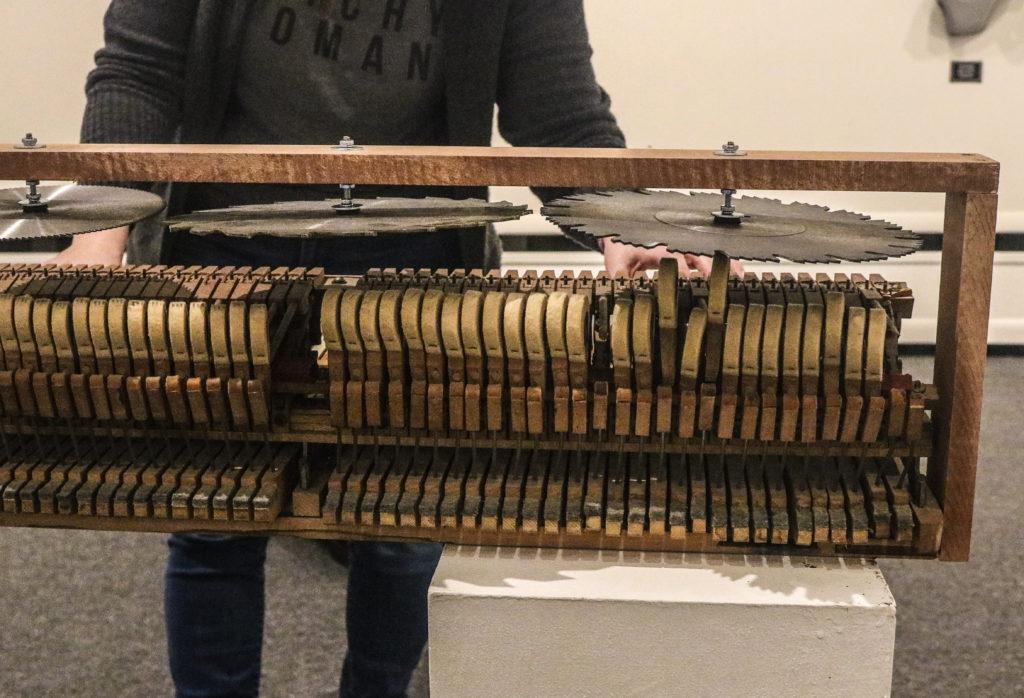
By Emma Schaefer
schaefer2@grinnell.edu
Ax, spoon, saw blades, wrench; these are just a few of the items that have become parts of musical instruments in the exhibition, “Dangerous Instruments,” created by Professor Eric McIntyre, music. The show, located in the Stewart Gallery in downtown Grinnell, has run since Jan. 7 and will end Feb. 1. The exhibit is made up of 19 musical instruments that McIntyre constructed using pieces of old farm equipment, scrap metal, and other cast-off material.
Walking around the exhibit feels like being in an alternative world where familiar objects have been recreated into musical instruments, and unlike many art exhibits, it invites viewers to interact with some of the pieces by gently playing them. McIntyre gave steel a new life as a bass drum, and a piano-like piece has been created using a piano action that resonates when the hammers hit saw blades. Another instrument consists of a pitchfork connected to a brass horn, and visitors can play it by hitting a small long-handled spoon against the pitchfork, releasing a deep metallic resonance.
McIntyre says he has been experimenting with the boundaries of what can be considered a musical instrument for some time. When he was in a junior high band, he and a friend would take parts of one instrument and stick them together with another to see what would happen. However, it wasn’t until a little over a decade ago when McIntyre started to build these instruments on a more serious scale.
“I’d get parts of brass horns and stick them together in unusual combinations to see what I could create,” McIntyre said. Around that same time, he was picking up equipment from farm auctions. At one auction, he found a large pitchfork sitting on a piece of metal, and after hitting it, he discovered that it resonated in the same way a tuning fork would. After that, he began noticing musical sounds in places many people usually don’t look for them. He said, “I bought a muffler off an old Chevy truck because of how well it sounded, and an old ax is now a fantastic bell.”
McIntyre says that how to play the instruments is one of the most frequent questions people ask him. Because of their unconventionality, the instruments give observers the freedom to explore without anyone telling strict boundaries of how an instrument should be played. McIntyre said, “I create a lot of the instruments, and then ask, how do I play this?” When asked what inspires him to create each piece, McIntyre said, “Sometimes it’s a sound I have in mind and sometimes it’s a visual.”
McIntyre hopes that people vieing “Dangerous Instruments” will be inspired “to listen to the world around them and see what it’s offering and be fascinated by the sounds.” He also hopes people can take away from the exhibit the ability to see — and listen to — the potential of objects that are cast off. “When someone holds up a pitchfork at an auction and is selling it for a dollar, they are essentially saying this has no value, and I look at it and say that has a lot of value to me.”
The closing reception for the exhibit will be held at the Stewart Gallery on Friday, Jan. 31, at 6:30 p.m. Beginning at 7 p.m., McIntyre will be demonstrating the instruments, playing a few precomposed pieces and doing some improvisation as well. This show is not one to miss, as McIntyre will be playing these one-of-a-kind instruments and will certainly inspire people to explore the possibilities of finding potential in unlikely places.




























































